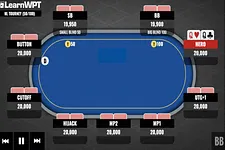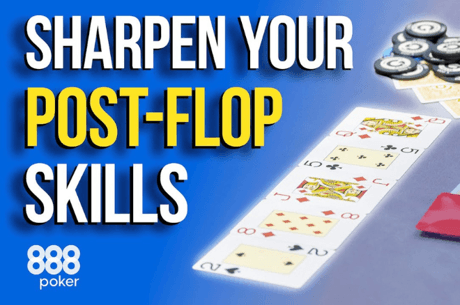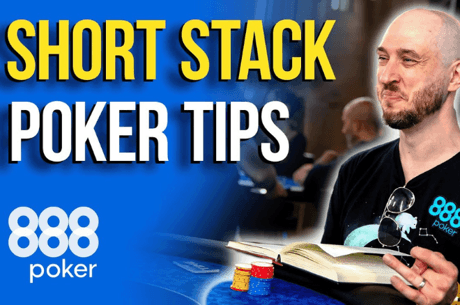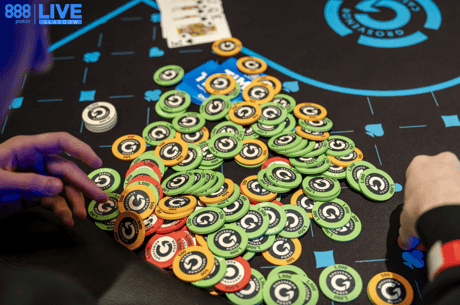How to React When Opponents Overbet the Turn

Overbetting the turn is a bit more fashionable than it used to be. Players are deploying the strategy in a variety of ways and some players don't know how to react.
What follows is a hand illustrating a player not responding well to a turn overbet, thereby not allowing himself the chance to make a decision on the river.
The Flop and Turn
In a six-handed game of 100NL ($0.50/$1) played online, a grizzled regular player opens to $2.50 second to act after under the gun folds. On the button another regular who is having a huge session (playing $550) calls. The initial raiser has $310 to start the hand, so play will be quite deep.
The flop came 8♥4♥3♠, and our initial raiser continued for nearly the size of the pot — $5.50 into a little less than $6 (after rake). The button called, and the turn brought the 7♣.
Two things to keep in mind as we move forward in this hand. First, having position is always advantageous, but it's an even bigger advantage on draw-heavy boards (like this one) that can change on the turn and the river — i.e., boards that are "dynamic" and not "static." Second, the deeper the stacks, the bigger an advantage being in position can be.
Here we have two complementary factors favoring the button — this especially dynamic board and the deep stacks. He should use these boosts to his advantage wisely.
Our initial raiser has fewer low card hands in his opening range than the button might have in his flat-calling range, simply because the button would three-bet a lot of high-card hands at this stack depth and would fold high cards on the flop. But on this turn, all sorts of hands the initial raiser could have opened in middle position — namely Jx10x, Jx9x, and 10x9x — have draws to the nuts, while Ax5x now has a double-gutshot straight draw.
The Turn Overbet
With $17 in the middle, our initial raiser decided to make a big overbet of $28.
I think players probably often react to such overbets in a knee-jerk fashion. But the first thing to realize is that this bet does not, in fact, put enormous pressure on the button. He can fold some weak hands with which he called on the flop, but if he calls, the pot will be $73 with $274 effective stacks behind. That's a very high pot-to-stack ratio going to the river.
Consider this, if the button has a bluff-catching hand, the player overbetting now can only have two cards. He can't have one of the two overcard straight draws like Jx10x, Jx9x, and 10x9x, nor a gutshot with 6xXx or 5xXx. Some flush draws also have straight draws on this board, but many won't. In other words, he can't hit every scary river card.
If the button has a draw to the nuts, of course, he will be able to use any scary river card better from position — whether he hits it or not — by just calling this turn.
Shutting Out Equity
It is all well and good to fold out equity if there are no consequences to doing so. Let's say the overbettor in this hand never has a made hand. Were that the case, the button could simply shove some range of hands on this turn to punish the overbettor. Then the overbettor can make a losing call or fold, and the button always comes away with the best of the pot.
But if the overbettor's range also includes 6x5x-suited and 8x8x, this strategy will be a complete disaster, because the button would be shoving $302 to protect himself in a pot under $50. The times he gets caught with little equity — always the case against a range with 8x8x and 6x5x on this board — he'll see three buy-ins go up in smoke.
You Can Play Small Pots With Deep Stacks
Playing a super deep-stacked pot against another regular does not mean one has to play huge pots. In fact, because the action can be reopened with grave consequences after a raise, the opposite will often be true. If the button calls his entire continuing range against this overbet, he can better control the size of the pot and how much money goes into it on what river cards.
Instead the button raised to $68. What was probably a mistake by the bettor (if $28 doesn't leverage the stacks, maybe $65 would have?), got rewarded because his opponent was worried about letting another card roll off, even though (not to be too shrill in repetition) river cards on balance help the button here more than they hurt.
This raise opened the door for magic from the out-of-position player's perspective. He now had the chance to shove all $300 into the pot with the current nuts — 6♠5♠ — which is what he did. Also worth noting — by making this reraise-shove possible, the button's raise effectively surrendered that great positional advantage with deep stacks we were discussing before.
The button, who had turned second set with 7♠7♥, now was in a putrid situation. After he threw up in his mouth a little, he had no good choices left.
That's another sign something has gone wrong — when you've taken a line that results in a choice between bad and worse.
Results and Reflections
The button did call the shove with his set of sevens and got all that money in with 22 percent equity. Good thing he wasn't facing pocket eights (which would be much worse, just 2 percent equity).
Reacting effectively to turn overbets often means simply not overreacting. Players should not be afraid to make decisions on river cards, especially when enjoying positional advantage. That's what poker is all about. Sometimes they'll get it wrong, but they won't have gotten lost on the way.
This strategy article by Gareth Chantler for PokerNews is sponsored by partypoker.









